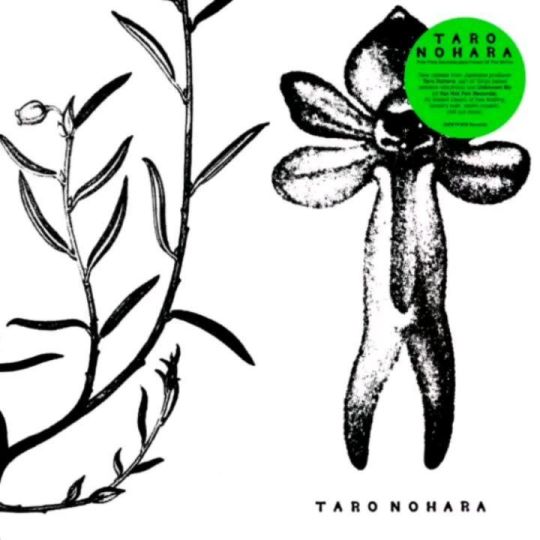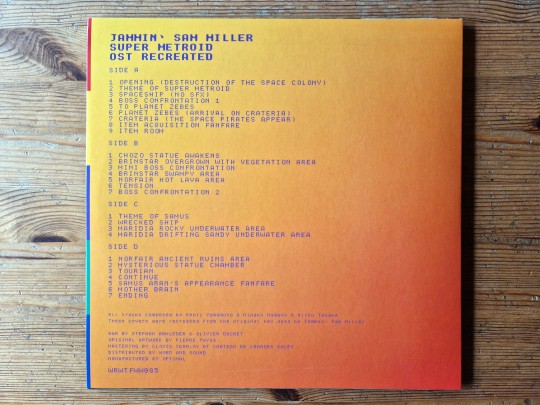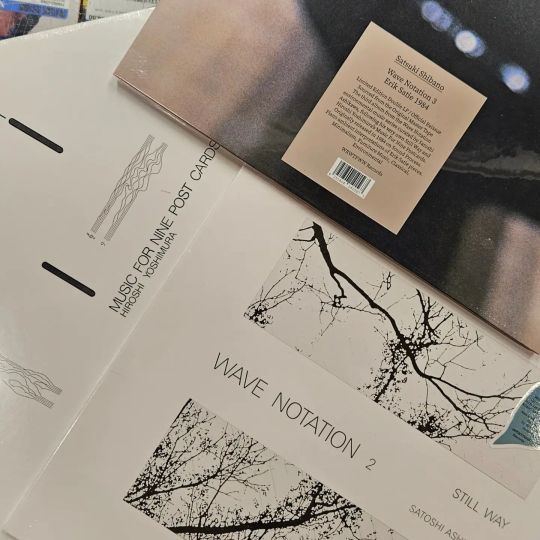#wrwtfww
Photo


Odyssey (Original Amiga Demoscene Soundtrack) (1991)
68 notes
·
View notes
Text
Pizza Hotline - “Emotion Engine”
Level Select [WRWTFWW, 2023]
3 notes
·
View notes
Photo

TARO NOHARA / POLY-TIME SOUNDSCAPES / FOREST OF THE SHRINE : WRWTFWW (LP) ジャンルの壁を超えて活躍するアーティスト、Taro Nohara(やけのはら)がスイスの名門レーベルWe Release Whatever The Fuck We Want Recordsからアルバムをリリース!Growing Bin Recordsからの前作『Hyper Nu Age Tekno!』や、H. TALKAHASHI、P-RUFFとのアンビエント・ユニット UNKNOWN MEのアルバム「Bishintai」でも魅せた美しい世界観はさらに深いフェーズへ突入。前作よりもビートレスに進化した楽曲はLeavingやRvng Intl.等とも共鳴する美しすぎる瞑想音楽。大推薦!(KEYWON) #TaroNohara#WRWTFWW#ambient#drone#lp#vinyl#record#stradarecords#dj#vinyljunkies#kobe#motomachi#strada#recordshop#recordstore#神戸レコード#元町レコード#レコード店#レコード#アナログ https://www.stradarecords.com/shop/item/27716/index.php (Strada Records) https://www.instagram.com/p/ClxAK6ABsfR/?igshid=NGJjMDIxMWI=
#taronohara#wrwtfww#ambient#drone#lp#vinyl#record#stradarecords#dj#vinyljunkies#kobe#motomachi#strada#recordshop#recordstore#神戸レコード#元町レコード#レコード店#レコード#アナログ
0 notes
Text

Super Metroid ! (2023)
#super metroid#musique#photographers on tumblr#super famicom#original photographers#metroid#super nes#スーパーファミコン#メトロイド#スーパーメトロイド#ost#wrwtfww records#nikon d780
48 notes
·
View notes
Text




Jammin' Sam Miller - Super Metroid OST Recreated | WRWTFWW Records | 2023 | Oxblood | /500
#jammin' sam miller#super metroid#wrwtfww records#vinyl#colored vinyl#lp#music#records#record collection#vgm#video game music#metroid#samus aran#pierre thyss
8 notes
·
View notes
Audio

25 notes
·
View notes
Audio
Midori Takada - You Who Are Leaving To Nirvana - a new album in which she adds musical accompaniment to Buddhist chants
Shomyo of Koya-san & Midori Takada
YOU WHO ARE LEAVING TO NIRVANA
WRWTFWW Records and MEG Museum (Geneva) are ecstatic to announce a new full length album by celebrated Japanese percussionist Midori Takada (Through The Looking Glass), in collaboration with Buddhist monks belonging to the Samgha group of the Shingon school of Koya-san, led by Reverend Syuukoh Ikawa. You Who Are Leaving To Nirvana is available on half speed mastered vinyl LP, housed in a 350gsm sleeve, with OBI, and liner notes, as well as on digipack CD.
Recorded at The Premises Studio (London) and in Tokyo in 2019,You Who are Leaving to Nirvana is a majestic work combining a suite of six Buddhist liturgical chants and a musical creation by Midori Takada. The Buddhist chants come from three types of repertoires: shomyo ("Teisan", "Unga-Bai", "Sange", "Taiyo"), but also goeika ("Kannon-Daiji") and mantra ("Hannya-Singyo").
After supervising the recording of the Buddhist chants, Midori Takada added her own compositions, with subtle layers of percussion and the melodies of her beloved marimba, giving full life to the sacred texts.
Reverend Syuukoh Ikawa explains: "Shomyo is a form of declamation of sacred esoteric texts, inherited over many generations. The power of words goes far beyond their mere pronunciation. I think there is something that words alone cannot really convey. If I recite prayers in a musical way, the feeling transmitted will be even stronger than if I say it normally, in everyday language. I think that the musicality of a work carries a hidden power that cannot be expressed in words alone. The setting of the music has an additional power for you and for those around you who listen to it. The words of a song are not just words set to music. They carry an additional hidden power that cannot be expressed in any other way. Listening to Midori Takada's musical performance, the words truly seem to come alive."
Original recordings of the Buddhist chants are held in the International Archives of Folk Music (IAFM) at the MEG Museum in Geneva.
The album sleeve features an artwork by famed Japanese sculptor Katsura Funakoshi selected by Midori Takada.
#Midori Takada#japan#buddhist#shomyo#ambient#liturgical#2022#wrwtfww records#new age#environmental music#percussion#marimba
14 notes
·
View notes
Text
youtube
This album is just perfect.
0 notes
Text
Iceberg En Voyage - Dominique Guiot
3 notes
·
View notes
Text
1 note
·
View note
Audio
Omodaka - “Ryotsu Jinku”
ZENTSUU: Collected Works 2001-2019 [WRWTFWW, 2023]
1 note
·
View note
Text

With the recent re-issue of Satsuki Shibano's "Erik Satie 1984" on the excellent Wrwtfww Records, the entire Wave Notation series is now available again for the first time in nearly 40 years!
Curated by Japanese musician Satoshi Ashikawa and released on his own Sound Process record label, the sound-defining Wave Notation environmental music series featured 3 influential Japanese albums released between 1982 and 1984. The aforementioned "Erik Satie 1984" by Satsuki Shibano follows Ashikawa’s own "Still Way" (1982) and Hiroshi Yoshimura's "Music For Nine Postcards" (1982). All 3 albums are defining markers of the Kankyō Ongaku movement and remain amongst the most influence Japanese ambient releases of all-time.
- Hiroshi Yoshimura - Music For Nine Post Cards - $55
- Satoshi Ashikawa - Still Way - $50
- Satsuki Shibano – Erik Satie 1984 - $85 (2xLP)
#wavenotation#hiroshiyoshimura#satoshiashikawa#satsukishibano#kankyoongaku
0 notes
Photo

Omodaka • ZENTSUU: Collected Works 2001-2019 WRWTFWW Records Electronic, 8bit/chiptune, folk, traditional, enka 28.10.22 . #DiscosQueVoyEscuchando https://www.instagram.com/p/CoanEerOCaQ/?igshid=NGJjMDIxMWI=
0 notes
Audio
Midori Takada - Cutting Branches For A Temporary Shelter - longform interpretation of the traditional Shona "Nhemamusasa"
WRWTFWW Records and MEG Museum (Geneva) are honored to present the first new solo album by renowned Japanese percussionist Midori Takada (Through The Looking Glass) in 23 years, Cutting Branches For A Temporary Shelter, available on vinyl LP, housed in a 350gsm sleeve, with OBI, and liner notes, as well as on digipack CD.
Recorded in a live setting and played with instruments conserved in the collections of the MEG Museum, Cutting Branches For A Temporary Shelter is Midori Takada’s very own rendition of "Nhemamusasa", a traditional work emblematic of the musical repertoire for mbira of the Shona of Zimbabwe, well known worldwide, thanks notably to its version by Paul F. Berliner included on the famed 1973 album The Soul of Mbira.
The choice of this title by Midori Takada evokes the links between traditional African and contemporary music which are the foundation of this work, and it also translates the resolutely multicultural vision of the artist.
Midori Takada explains: "African music is remarkable for its polyrhythms. Not only are there simultaneously several rhythmic motifs, sometimes as many as ten, but furthermore it may be that the part played by each musician has its own starting point and its own pace, all combining to form a cycle. All the cycles progress at the same time according to a single metrical structure which functions as a reference point, but which is not played by any one person from beginning to end. The structure emerges out of the multi-level parts, all different. With the Shona, the musical system is based on the polymelody: one performs simultaneously several melodic lines which are superimposed, each having its own rhythmic organization. It is truly captivating. In Western classical music, one four-beat rhythm induces some precise temporal framework and regular reference points, which come on the strong beats 1 and 3. But in the logic of the Shona musical system, and in other African music, the melody can begin in the very middle of the cycle and be continued up to some other place in an autonomous manner, as if it had its own personality. It’s very rich."
The album comes with in-depth liner notes that include an interview with Midori Takada, a point of view by Zimbabwean scholar, musician and activist Forward Mazuruse, and background information on the project by Isabel Garcia Gomez and Madeleine Leclair from MEG Museum.
The sleeve features an artwork by celebrated Zimbabwean painter Portia Zvavahera.
Part of the budget for the album was donated to Forward Mazuruse’s Music For Development Foundation whose aim is to identify, nurture, and record young but underprivileged musicians in Zimbabwe.
#Midori Takada#Nhemamusasa#WRWTFWW Records#new age#ambient#japan#jazz#mbira#percussion#2022#zimbabwe#shona#african music
6 notes
·
View notes